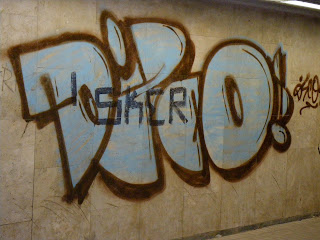This morning I headed over to the Hospital around 9AM for some blood work. I arrived at the
XCell Center which was located on the third floor of the local hospital. I was shown to the waiting room where there was plenty of seating, a toy corner for kids, and an espresso machine for patients and visitors to help themselves.
After filling out and signing some more
paper work, I went down the hall to the lab for a quick blood test, then it was back to the reception room to await the results. Barring any unforeseen problems with my blood work, I would go ahead and have the
bone marrow collection procedure from which the doctors would isolate and harvest as many of my
stem cells as they could.
The facility itself was a little stark, but clean. The reception room had windows looking out onto the
Rhine. The receptionist was friendly and spoke a fair amount of English.
Once my tests came back, I was ready for the collection procedure. I met with the doctor who would be performing both the bone marrow collection and the
angioraphy and had a chance to ask him any questions I still had. I got the sense that he was genuinely listening to my concerns and trying to give me the best and most honest answers possible.
A nurse accompanied me down stairs to the "sterile" room where my bone marrow would be extracted. I had to put covers over my shoes and hair, but that was it, no hospital gown or anything like that.
I had to lie on my side in the fetal position with my jeans pulled down just a bit in order to expose the spot on my hip where the doctor would insert the needle. I asked about a sedative, but the doctor thought that it was unnecessary.
A small side note about me: I HATE needles. It's not the pain of the needle or anything like that, I guess it's just the knowledge that there is a foreign device inserted under my skin that makes me panic. Getting a shot, having blood drawn, etc, it all makes me very anxious. In retrospect, i should have taken a sedative, but that is only because of my personally phobia of needles.
Anyhow, the doctor first injected the site with a local anesthetic. After that had a minute or two to take effect, the extraction needle was inserted. Now, I am not going to pretend like it felt good at all, because it didn't. That being said, the discomfort was completely manageable. I would say the most noticeable thing is a sensation of pressure. My best suggestion is to try as much as you can to relax, possibly try some deep breathing techniques. I feel like some of the pain was just my imagination because I was a bit worked up not knowing what to expect.
The doctor was nice and talked to me throughout the procedure, probably to help keep my mind off of things, and the nurse was there too, though she barely spoke any english. Actually, it did bother me a little bit that the nurse assigned to me couldn't really understand any of my questions. It would have been nice to be able to ask her things prior to the procedure, but it was not a big deal. I also noticed that, though nice and all, the "bedside manner" in Germany is a little brusque. I think Germans in general are just more straight forward or abrupt in their mannerisms. There does not seem to be the same kind of "hand-holding" that you might find in the states. They are all about getting down to business, not that there is really anything wrong with that.
So, the extraction only took about 15 minutes, though it can take up to 30. I was happy to be off the table and was able to walk around immediately. They put a bandage over the puncture wound and after spending about 20 minutes in the reception room having a coffee, I was free to head back to the hotel. I walked with a slight limp for the rest of the day, but pretty much felt fine and was easily able to grab a cab back to the hotel.
Tomorrow is a "rest day" as they will need that time to isolate the stem cells from the bone marrow. As long as I am feeling alright, I'm, going to take tomorrow to check out the city of Dusseldorf.
Day one seems to have been a success so far. It will be interesting to see how many stem cells they are able to get from the bone marrow they extracted. 15 minutes of discomfort doesn't seem to bad in the general scheme of things, especially when it could result in major quality-of-life improvements...
What do you think? After hearing the details of the bone marrow extraction, would you do it?











